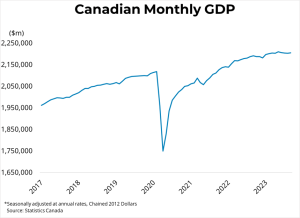
BRITISH COLUMBIA – Canadian real GDP rose 0.1 per cent from the prior month in September, following contractions in the prior three months.
Manufacturing jumped 0.9 per cent in September as inventory formation pushed economic activity upwards. Construction activity rose by 1 per cent, with residential building up 3.9 per cent, the largest gain since April 2021. Offices of real estate agents and brokers fell for the third consecutive month, dropping 4.1 per cent as sales weakened into the fall.
Preliminary estimates suggest that output in the Canadian economy rose 0.2 per cent in October.
GDP declined 0.3 per cent in the third quarter, erasing a 0.3 per cent gain in the second quarter. The slowdown was driven in part by weaker exports, which declined 1.3 per cent from the prior quarter, led by weaker petroleum exports.
Housing investment rose 2 per cent from the prior quarter but an increase in new construction (+6.4 per cent) was offset by a contraction in ownership transfer costs representing resale activity (-4.3 per cent). Employee compensation rose 1.3 per cent and household disposable income rose 1 per cent, driving the household saving rate to 5.1 per cent in the third quarter.
Canadian GDP bucked expectations and contracted in the third quarter, declining by 1.1 per cent on an annualized basis. At the same time, Statistics Canada revised its second-quarter GDP figure considerably upward, meaning that the economy has again avoided entering a technical recession.
With October’s preliminary figure again positive, the Canadian economy appears weak but is so far not shrinking substantially in aggregate terms. However, with very soft GDP figures occurring amid a rising unemployment rate and some progress on inflation, markets continue to expect that the Bank of Canada is likely at the end of its tightening cycle.
The next rate announcement is on next Wednesday, December 6th.
Source: bcrea.bc.ca

